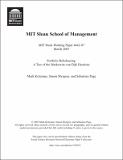| dc.description.abstract | Institutional investors usually employ mean-variance analysis to determine optimal
portfolio weights. Almost immediately upon implementation, however, the portfolio’s
weights become sub-optimal as changes in asset prices cause the portfolio to drift away
from the optimal targets. In an idealized world without transaction costs investors would
rebalance continually to the optimal weights. In the presence of transaction costs
investors must balance the cost of sub-optimality with the cost of restoring the optimal
weights. We apply a quadratic heuristic to address the asset weight drift problem, and we
compare it to a dynamic programming solution as well as to standard industry heuristics.
Our tests reveal that the quadratic heuristic provides solutions that are remarkably close
to the dynamic programming solutions for those cases in which dynamic programming is
feasible and far superior to solutions based on standard industry heuristics. In the case of
five assets, in fact, it performs better than dynamic programming due to approximations
required to implement the dynamic programming algorithm. Moreover, unlike the
dynamic programming solution, the quadratic heuristic is scalable to as many as several
hundreds assets. | en |
